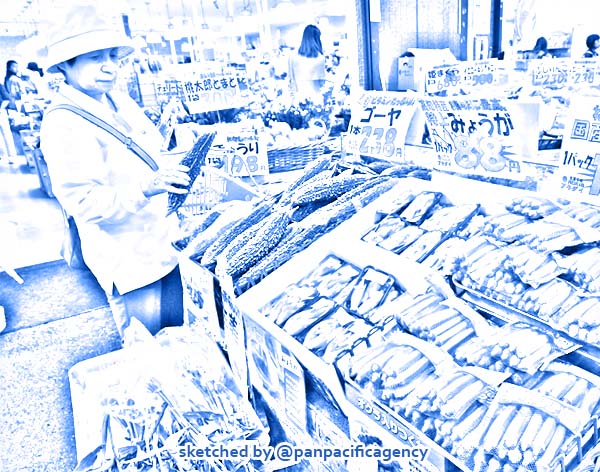Japan’s consumption tax raised to 10% amid swelling welfare costs

Japan's consumption tax rate was raised to 10 percent from 8 percent on Tuesday, after twice being delayed. Photo by the Kyodo. Sketched by the Pan Pacific Agency.
TOKYO, Oct 1, 2019, Kyodo. Japan’s consumption tax rate was raised to 10 percent from 8 percent on Tuesday, after twice being delayed, as the government is struggling to cover ballooning social security costs stemming from the country’s aging population and falling birthrate, reported the Kyodo.
Prime Minister Shinzo Abe told reporters at his office the latest consumption tax hike is a “big step forward” in pushing ahead with social security reforms. “We will closely monitor the effect of the consumption tax increase and take all possible measures” to alleviate any negative impact.
Nearly half of the 5.7 trillion yen ($52.8 billion) additional annual revenue expected from the tax hike will be used to improve welfare programs, centering on free preschool education that started the same day.
But the first tax hike in five years caused confusion among retailers and consumers as items such as food deemed necessary in daily lives are exempted from the change under the government’s scheme aimed at minimizing its potential negative impact on spending. As a result, different rates have been introduced.
The second round of the two-stage consumption tax increase was originally scheduled for October 2015 following the first stage from 5 percent to 8 percent in April 2014.
But the hike was first postponed to April 2017 and then to this month, because of fears it could dampen consumer spending and hurt the whole economy, as was the case after Japan raised the tax previously.
Noting that the tax increase is important for securing welfare expenditures, Finance Minister Taro Aso told a press conference the government is taking “more than enough countermeasures” to soften any potential negative impact.
The government has maintained its assessment that Japan’s economy is “recovering at a moderate pace” with domestic demand remaining solid.
But there are concerns that the economy may be hit hard by downside risks abroad, including U.S.-China trade tensions.
To cushion any negative effects, the government has taken a set of measures ranging from a reduced tax rate system for food and other daily items to a reward points program for cashless payments, as well as tax breaks on cars and houses.
Tokyo saw a surge in demand ahead of the previous hike in 2014 and a plunge afterward, drawing the economy into a slow-growth state.
Aso, who doubles as deputy prime minister, said there were no reports of a major rise in last-minute demand as was seen in the previous increase thanks to the government’s alleviation steps.
Some critics have pointed out that it is paradoxical that the government is aiming to achieve fiscal consolidation on the one hand and is boosting public spending on the other in an attempt to prop up domestic demand.
Japan continues to issue deficit-covering bonds to pay for swelling welfare costs, including public pensions and medical care, making its fiscal health the worst among advanced economies.
Looking ahead, some economists projected Japan’s growth will shrink in the October-December quarter despite the government measures, saying an increase in last-minute demand did not occur because consumer spending, one of the key components of Japan’s gross domestic product, had already been sluggish prior to the hike.
Opposition parties stepped up their criticism of the tax increase, with Japan Innovation Party leader Ichiro Matsui calling for a halt. “What we need are economic policies that could enhance private consumption, rather than a tax hike that could curb spending,” he said in a statement.
Beyond economic implications, confusion over the two-tiered tax system spread nationwide, with some shop clerks saying they were worried about whether they could correctly handle cash registers that are corresponding to the complex scheme.
Food and drink except alcohol will continued to be taxed at 8 percent. But non-food daily use items are taxed at 10 percent.
Tax rates also vary depending on where food items are consumed. A meal consumed at a shop or restaurant is taxed at 10 percent, but only 8 percent is applied to take-out food.
Meanwhile, reward points will be given for cashless payments through June 2020. The rebate rates will be 5 percent at small and medium-sized stores and 2 percent at major chain stores, including convenience stores.
The complex scheme is also designed to promote cashless transactions in Japan, which is lagging behind other countries, including China and South Korea, in the domain.
The following is a chronology of major events related to the consumption tax in Japan
April 1989 — Prime Minister Noboru Takeshita’s government introduces a 3 percent consumption tax.
April 1997 — Prime Minister Ryutaro Hashimoto’s government raises the tax rate to 5 percent.
June 2012 — Then-ruling Democratic Party of Japan, opposition Liberal Democratic Party and New Komeito party agree to raise the tax in stages to 10 percent and implement reforms to cut welfare costs.
April 2014 — LDP-led government under Prime Minister Shinzo Abe lifts the rate to 8 percent.
November — Abe delays plans for the additional hike, to 10 percent to April 2017 from October 2015, to safeguard economic growth.
December 2015 — LDP-Komeito coalition agrees to exempt food and other daily necessities from the planned tax hike.
June 2016 — Abe says the tax hike will again be postponed to October 2019.
October 2018 — Abe orders his government to compile measures to mitigate the potential negative impact on the economy from the planned tax hike.
October 1, 2019 — Government raises the tax rate to 10 percent.